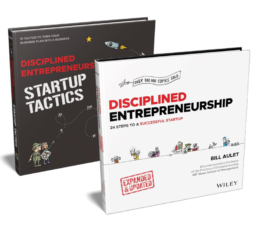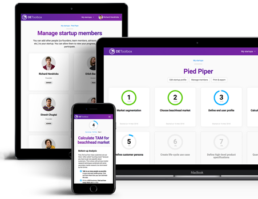Step 3
End-User Profile
Your analysis of your target customer is nowhere near complete, but the End User Profile points you in the right direction for future steps. The journey is only beginning, but you are starting off with the right focus—a well-defined target customer.
This is a critical step in your search for specificity and starting to make your customer concrete and very real. It is also a critical part of the process to help ingrain the mentality that you should build your company around your customer’s needs, not based on your interests and capabilities. The latter does matter, but it is secondary to how you should think about your business.
Now that you know the profile of the end user, you can assess future interactions you have with potential customers to determine whether they are actually in your End User Profile and are worth your time. If they do not fit the profile, engaging with their needs will distract you from building a great product to meet a specific customer’s pain. You can now estimate how many end users exist in your market, which leads you directly to Step 4, Estimate the Total Addressable Market (TAM) for the Beachhead Market.
Videos
Worksheets
Examples
Content will be published as it becomes available.
Topics
Process Guide
This book will describe the process for one-sided markets, where only one kind of end user is required for the product to work so that you have a good grounding in the fundamental principles of building an End User Profile. Multisided markets, such as marketplace platforms like eBay that attract both buyers and sellers, use the same techniques described herein, but they require developing an End User Profile for each side of the market. The skills are the same but just have to be used on all sides of these multisided markets.
The fundamental concept of the End User Profile is that it must be a person and not an organization or department. In the end, it is a human being, or set of human beings, who will use your product or oversee the use of your product, so you need to deeply understand this person, or as I say in class, you must “walk a few miles in their shoes.”
There are six items that are the most common when building a useful End User Profile. You may want to expand or contract this list depending on the complexity and economics of your situation.
Demographics: Demographics are quantifiable data that can be used to identify your target end user and also filter out those who are not your end user. These are things like gender, age, income, geographic location, level of education, school attended, and other relatively easily measurable factors. The good news is that these are pretty easy to figure out, but the bad news is that they all might not be useful in understanding your end user for your context. That is the art here. Knowing your end users are women in their 20s, even if you narrow the group down to a certain income group and geographic location, does not gain you much information if there exist wildly divergent attitudes, values, or fears in that group. Analyze the demographics, but then decide how much emphasis to put on the different elements as you move forward. Use the worksheet below and sources online to customize which demographics you collect for your situation. Remember more is better to start, within reason.
Psychographics: Merriam-Webster Dictionary defines psychographics as “market research or statistics classifying population groups according to psychological variables (as attitudes, values, or fears).” The simple working definition I give in class is that psychographics refers to the qualitative description of your target end users. What are their aspirations? What do they fear most? What gets them promoted or makes them more money? Who are their heroes? Understand how and why they behave the way they do, rather than the general identifiable characteristics that demographics give you. Psychographics are immensely valuable but are much harder to get or analyze. Lots of government or industry database services like Facebook, can break down information by demographics, but far fewer can be searched by psychographics. This makes the additional items below even more important because they will help you find them as well as better understand them.
Proxy Product: What products do these end users also buy today? This information is valuable because it shows how the end users already behave, instead of how they might theoretically behave if your product were to exist. Sometimes, proxy products are complementary products. If someone owns a Lexus automobile (a high-end and expensive but high-quality car), they would likely buy an expensive but high-quality brand of tires like Michelin. Other times, proxy products demonstrate similar demographic and psychographic characteristics. If someone buys a Toyota Prius, a hybrid gas-electric car that is more expensive than Toyota’s Camry sedan, they are indicating that they are likely interested in mitigating their environmental impact and that they have enough money to act on that passion. They are likely good candidates to also own, or at least be very interested in, solar panels.
Watering Holes: Watering holes are the places where your end users congregate and exchange information. They are reliable places for information about your product to be spread by “word of mouth,” which is far more effective than advertising. They also provide some corroboration for your demographic and psychographic information because you can infer things about people by the company they keep. The forms that watering holes take can be physical in nature such as industry conferences, Saturday morning soccer fields, bars (literal watering holes) and the like. More and more so, fortunately for entrepreneurs because this can be a much more efficient and rapid way to reach them, these watering holes are digital in nature like online platforms such as Facebook, LinkedIn, Reddit or specific industry group forums.
Day in the Life: Literally tell the story of what it is like to walk in your end user’s shoes for a typical day. In this step, since you have not yet focused on one end user you will call the Persona, the “day in the life” will be a composite—but make it a composite of multiple end-users whom you have actually spent a day observing and talking with. The resulting story sets aside abstract studies and statistics and brings it all home to your team by helping them understand what happens in real life. It also reinforces and helps you refine the rest of your End User Profile.
Biggest Fears and Motivators: What keeps your end users awake at night more than anything else? What are your customers’ top priorities—their fears and motivators? I don’t mean in relation to the product you’re hoping they will buy; I mean in general. When you do your primary market research, sit with end users and make a comprehensive list of all their concerns. Then, ask them to weigh their priorities by giving more points to higher priorities, with a total of 100 points across all the priorities. This exercise forces prioritization. As part of the End User Profile, you’ll want a weighted list of your end user’s top five or so priorities. Confirm this list with the end users you talk to as much as possible. This list will be extremely useful going forward.
To re-emphasize a critical point from earlier in this chapter, your PMR from previous steps will be very useful here, but you will likely need to do additional PMR to complete your End User Profile. Do not start taking shortcuts at this critical time. Specifically, don’t guess or make stereotypical judgments about what your End User Profile “should” look like in an attempt to save time. In the end, you want information about real people, because it’s real people who will use your product, not fictional characters in a marketing document.
Books
Content will be published as it becomes available.
Other Resources
Content will be published as it becomes available.
The Disciplined Entrepreneurship Toolbox
Stay ahead by using the 24 steps together with your team, mentors, and investors.
The books
This methodology with 24 steps and 15 tactics was created at MIT to help you translate your technology or idea into innovative new products. The books were designed for first-time and repeat entrepreneurs so that they can build great ventures.

